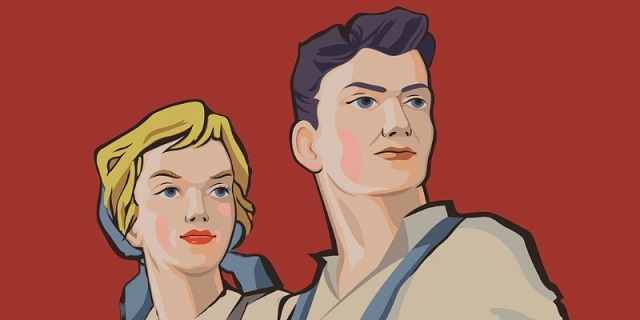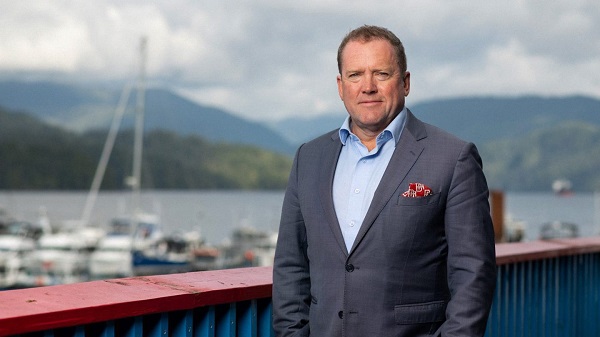Fraser Institute
‘New Socialist Man’ was a selfish corrupt cheat

From the Fraser Institute
It’s a common trope that capitalism corrupts. Anyone who has spent time with our species knows that we can be avaricious, materialist and selfish. Tempting as it may be to think that socialism would make us better, it seemed to make us worse.
The communist revolution sought to reshape the economy by giving government control over the means of production. But socialist revolutionaries had more than the economy in their sights. They aimed for nothing less than an extreme makeover of human nature. Unfortunately, actual socialism seemed to make people worse, not better.
Why did socialists seek to change man?
Marx believed that “the essence of man” was “no abstraction inherent in each single individual.” Instead, this essence was “the ensemble of the social relations.” And by changing social relations, he believed man could be changed for the better.
For his part, Stalin saw that certain aspects of human nature were stumbling blocks to the socialist dream. In 1935 he told a conference of collective farm labourers that “a person is a person. He wants to own something for himself.” It will “take a long time yet to rework the psychology of the human being, to reeducate people to live collectively.”
But Stalin and others believed that, given enough time, socialism would create what they called the “New Socialist Man.” He would be intelligent, healthy, muscular, selfless and supremely dedicated to the cause. Basically, he’d look like everyone in the socialist “realist” paintings that the government compelled artists to paint.
He would care less about his private life and his family and more about society-at-large. It was in this vein that Soviet education theorists taught that “By loving a child, the family turns him into an egotistical being, encouraging him to see himself as the centre of the universe.” In the place of such “egoistic love” the state encouraged “rational love” of the broader “social family.”
Socialists had a practical reason for remaking man. Without economic freedom, citizens had little incentive to produce. In a capitalist society, Adam Smith’s butcher, brewer and baker serve us dinner because they are incentivized to do so; it puts money in their pockets and food in the bellies of their children. But in a state-run canteen the workers were paid whether they served decent food or not. The socialists hoped that by remaking human nature—by creating a New Socialist Man motivated to serve others and not just himself and his family—they could solve this incentive problem.
How did people change?
As I’ve explained in an earlier post, the incentive problem was never solved. The New Socialist Man never got very good at serving others, so socialist societies were systematically poor.
But what happened to human nature? Did they succeed in changing it? The species evolves over generations so, of course, the seven-decade socialist experiment didn’t alter human genes (when Marx sent a copy of Das Kapital to Charles Darwin, it apparently sat unread on Darwin’s shelf). But socialism did have a profound effect on cultural norms and attitudes. And these changes were almost entirely for the worse.
In my book on Poland with Pete Boettke and Konstantin Zhukov, we quote one Pole from the late-1980s who observed: “one can make a generalization that everybody in Poland who has the chance engages in a good deal of stealing, cheating, and supplementing his or her income by illegal means.”
Another complained: “Why must I so often do things to get a promotion or improve my family’s living standard that run against my conscience? Why and how has it become true that I am a swine? When did I realize it, and when did I stop caring?”
Socialist planners also worried about cultural decline: “What is going to happen to the character of the young generation,” a state planner asked, “if from the very beginning of their working career in the enterprise, they are being taught and morally forced to cheat at the expense of the whole society?”
In our Estonia book, we quote Václav Havel, the poet-playwright-dissident who became Czechoslovakia’s last president. He identified the problem in his New Year’s address of 1990:
We fell morally ill because we became used to saying something different from what we thought. We learned not to believe in anything, to ignore each other, to care only about ourselves. Concepts such as love, friendship, compassion, humility or forgiveness lost their depth and dimensions and for many of us they represented only psychological peculiarities… I am talking about all of us. We had all become used to the totalitarian system and accepted it as an unchangeable fact, and thus helped to perpetuate it. In other words, we are all—though naturally to differing extents— responsible for the operation of totalitarian machinery, none of us is just its victims; we are all also its cocreators.
Even Soviet leader Mikhail Gorbachev complained in his autobiography of “a gradual erosion of the ideological and moral values of our people.”
Why was the New Socialist Man a worse man?
The control problem is one explanation for this gradual erosion of moral values. With no carrots in the form of market incentives, socialist leaders deployed a terrifying array of sticks—mass deportation, widespread surveillance, arrests and slave labour. They even weaponized children against their parents (a topic I plan to cover in a future post). And since the socialist revolution was built around the notion of class warfare, the socialists felt justified in using these sticks against any class that stood in their way: kulaks, capitalists, ethnic minorities, nationalists, internationalists, left deviationists, right deviationists, religious leaders, cultural icons and intellectuals.
In the face of such widespread terror, it’s no wonder that the socialist state bread cultural habits of anger and distrust. But terror was not the only source of cultural rot. The dysfunctional economy, with its everyday contradictions and absurdities, was another source.
Despite the promise of material abundance, shortages were endemic to the socialist economy. Consumers routinely faced shortages of soap, coffee, sugar, laundry detergent, cigarettes, rubber, transportation, household appliances, cars, housing, clothing and—above all—meat. The shortages arose in part by accident. Without market-determined prices, planners were often flying blind. But shortages were also purposefully engineered by bureaucrats to solicit bribes from rationed consumers.
The only legal way that people could get what they wanted was to wait in line—sometimes for weeks on end. And even then, thugs could jump the queue. Those who didn’t want to wait would resort to bribery and the black market. Even socialist planners and factory leaders had to use the black market to meet their targets in the Five-Year plans. People commodified their relationships, using friends and family to supply them with what the socialist economy would not. This gave rise to what was called “an economy of favours” and the saying that “One must have, not a hundred rubles, but a hundred friends.”
The political scientists John Clark and Aaron Wildavsky describe the dynamic:
When the need for social or political contacts to accomplish anything—from getting enough steel in order to meet one’s factory’s plan quota to finding chocolate for a child’s birthday party—become indispensable… human relations suffer. People expect both too much and too little from friends, family, and acquaintances: too much, since almost every aspect of your life depends on what others can do for you; too little, since the instrumentalization of these relations means that they are sucked dry of any inherent pleasure.
The anthropologist Janine Wedel describes the effect on a Polish woman who manipulated her connections to obtain curtains: “[She] feels a kind of revengeful pride—she is happy to manipulate a system that has humiliated her all her life.”
As we put it in our Poland book: “The new socialist man was not the selfless creature of Marxist writing. He was a grifter who had no choice but to make his way by cheating the rest of society, just as the rest of society cheated him.”
It’s a common trope that capitalism corrupts. Anyone who has spent time with our species knows that we can be avaricious, materialist and selfish. Tempting as it may be to think that socialism would make us better, it seemed to make us worse.
The communist revolution sought to reshape the economy by giving government control over the means of production. But socialist revolutionaries had more than the economy in their sights. They aimed for nothing less than an extreme makeover of human nature. Unfortunately, actual socialism seemed to make people worse, not better.
Why did socialists seek to change man?
Marx believed that “the essence of man” was “no abstraction inherent in each single individual.” Instead, this essence was “the ensemble of the social relations.” And by changing social relations, he believed man could be changed for the better.
For his part, Stalin saw that certain aspects of human nature were stumbling blocks to the socialist dream. In 1935 he told a conference of collective farm labourers that “a person is a person. He wants to own something for himself.” It will “take a long time yet to rework the psychology of the human being, to reeducate people to live collectively.”
But Stalin and others believed that, given enough time, socialism would create what they called the “New Socialist Man.” He would be intelligent, healthy, muscular, selfless and supremely dedicated to the cause. Basically, he’d look like everyone in the socialist “realist” paintings that the government compelled artists to paint.
He would care less about his private life and his family and more about society-at-large. It was in this vein that Soviet education theorists taught that “By loving a child, the family turns him into an egotistical being, encouraging him to see himself as the centre of the universe.” In the place of such “egoistic love” the state encouraged “rational love” of the broader “social family.”
Socialists had a practical reason for remaking man. Without economic freedom, citizens had little incentive to produce. In a capitalist society, Adam Smith’s butcher, brewer and baker serve us dinner because they are incentivized to do so; it puts money in their pockets and food in the bellies of their children. But in a state-run canteen the workers were paid whether they served decent food or not. The socialists hoped that by remaking human nature—by creating a New Socialist Man motivated to serve others and not just himself and his family—they could solve this incentive problem.
How did people change?
As I’ve explained in an earlier post, the incentive problem was never solved. The New Socialist Man never got very good at serving others, so socialist societies were systematically poor.
But what happened to human nature? Did they succeed in changing it? The species evolves over generations so, of course, the seven-decade socialist experiment didn’t alter human genes (when Marx sent a copy of Das Kapital to Charles Darwin, it apparently sat unread on Darwin’s shelf). But socialism did have a profound effect on cultural norms and attitudes. And these changes were almost entirely for the worse.
In my book on Poland with Pete Boettke and Konstantin Zhukov, we quote one Pole from the late-1980s who observed: “one can make a generalization that everybody in Poland who has the chance engages in a good deal of stealing, cheating, and supplementing his or her income by illegal means.”
Another complained: “Why must I so often do things to get a promotion or improve my family’s living standard that run against my conscience? Why and how has it become true that I am a swine? When did I realize it, and when did I stop caring?”
Socialist planners also worried about cultural decline: “What is going to happen to the character of the young generation,” a state planner asked, “if from the very beginning of their working career in the enterprise, they are being taught and morally forced to cheat at the expense of the whole society?”
In our Estonia book, we quote Václav Havel, the poet-playwright-dissident who became Czechoslovakia’s last president. He identified the problem in his New Year’s address of 1990:
We fell morally ill because we became used to saying something different from what we thought. We learned not to believe in anything, to ignore each other, to care only about ourselves. Concepts such as love, friendship, compassion, humility or forgiveness lost their depth and dimensions and for many of us they represented only psychological peculiarities… I am talking about all of us. We had all become used to the totalitarian system and accepted it as an unchangeable fact, and thus helped to perpetuate it. In other words, we are all—though naturally to differing extents— responsible for the operation of totalitarian machinery, none of us is just its victims; we are all also its cocreators.
Even Soviet leader Mikhail Gorbachev complained in his autobiography of “a gradual erosion of the ideological and moral values of our people.”
Why was the New Socialist Man a worse man?
The control problem is one explanation for this gradual erosion of moral values. With no carrots in the form of market incentives, socialist leaders deployed a terrifying array of sticks—mass deportation, widespread surveillance, arrests and slave labour. They even weaponized children against their parents (a topic I plan to cover in a future post). And since the socialist revolution was built around the notion of class warfare, the socialists felt justified in using these sticks against any class that stood in their way: kulaks, capitalists, ethnic minorities, nationalists, internationalists, left deviationists, right deviationists, religious leaders, cultural icons and intellectuals.
In the face of such widespread terror, it’s no wonder that the socialist state bread cultural habits of anger and distrust. But terror was not the only source of cultural rot. The dysfunctional economy, with its everyday contradictions and absurdities, was another source.
Despite the promise of material abundance, shortages were endemic to the socialist economy. Consumers routinely faced shortages of soap, coffee, sugar, laundry detergent, cigarettes, rubber, transportation, household appliances, cars, housing, clothing and—above all—meat. The shortages arose in part by accident. Without market-determined prices, planners were often flying blind. But shortages were also purposefully engineered by bureaucrats to solicit bribes from rationed consumers.
The only legal way that people could get what they wanted was to wait in line—sometimes for weeks on end. And even then, thugs could jump the queue. Those who didn’t want to wait would resort to bribery and the black market. Even socialist planners and factory leaders had to use the black market to meet their targets in the Five-Year plans. People commodified their relationships, using friends and family to supply them with what the socialist economy would not. This gave rise to what was called “an economy of favours” and the saying that “One must have, not a hundred rubles, but a hundred friends.”
The political scientists John Clark and Aaron Wildavsky describe the dynamic:
When the need for social or political contacts to accomplish anything—from getting enough steel in order to meet one’s factory’s plan quota to finding chocolate for a child’s birthday party—become indispensable… human relations suffer. People expect both too much and too little from friends, family, and acquaintances: too much, since almost every aspect of your life depends on what others can do for you; too little, since the instrumentalization of these relations means that they are sucked dry of any inherent pleasure.
The anthropologist Janine Wedel describes the effect on a Polish woman who manipulated her connections to obtain curtains: “[She] feels a kind of revengeful pride—she is happy to manipulate a system that has humiliated her all her life.”
As we put it in our Poland book: “The new socialist man was not the selfless creature of Marxist writing. He was a grifter who had no choice but to make his way by cheating the rest of society, just as the rest of society cheated him.”
Business
Carney government should privatize airports—then open airline industry to competition

From the Fraser Institute
By Alex Whalen and Jake Fuss
This holiday season, many Canadians will fly to spend time to with family and friends. But air travellers in Canada consistently report frustration with service, cost and choice. In its recent budget, the Carney government announced it will consider “options for the privatization of airports.” What does this mean for Canadians?
Up until the 1990s, the federal government served as both the owner and operator of Canada’s major airports. The Chrétien government partially privatized and transferred the operation of major airports to not-for-profit airport authorities, while the federal government remained the owner of the land. Since then, the federal government has effectively been the landlord for Canada’s airports, collecting rent each year from the not-for-profit operating authorities.
What would full privatization of airports look like?
If the government allows private for-profit businesses to own Canada’s major airports, their incentives would be to operate as efficiently as possible, serve customers and generate profits. Currently, there’s little incentive to compete as the operating authorities are largely unaccountable because they only report to government officials in a limited form, rather than reporting directly to shareholders as they would under privatization. Private for-profit airports exist in many other countries, and research has shown they are often less costly for passengers and more innovative.
Yet, privatization of airports should be only the first step in a broader package of reforms to improve air travel in Canada. The federal government should also open up competition by creating the conditions for new airports, new airlines and new investment. Currently, Canada restricts foreign ownership of Canadian airlines, while also restricting foreign airlines from flying within Canada. Consequently, Canadians are left with little choice when booking air travel. Opening up the industry by reversing these policies would force incumbent airlines to compete with a greater number of airlines, generating greater choice and likely lower costs for consumers.
Moreover, the federal government should reduce the taxes and fees on air travel that contribute to the cost of airline tickets. Indeed, according to our recent research, among peer countries, Canada has among the most expensive air travel taxes and fees. These costs get passed on to consumers, so it’s no surprise that Canada consistently ranks as a very expensive country for air travel.
If the Carney government actually privatizes Canada’s airports, this would be a good first step to introducing greater competition in an industry where it’s badly needed. But to truly deliver for Canadians, the government must go much further and overhaul the numerous policies, taxes and fees that limit competition and drive up costs.
Business
Ottawa’s gun ‘buyback’ program will cost billions—and for no good reason

From the Fraser Institute
By Gary Mauser
The government told Cape Bretoners they had two weeks to surrender their firearms to qualify for reimbursement or “buyback.” The pilot project netted a grand total of 22 firearms.
Five years after then-prime minister Justin Trudeau banned more than 100,000 types of so-called “assault-style firearms,” the federal government recently made the first attempt to force Canadians to surrender these firearms.
It didn’t go well.
The police chief in Cape Breton, Nova Scotia, volunteered to run a pilot “buyback” project, which began last month. The government told Cape Bretoners they had two weeks to surrender their firearms to qualify for reimbursement or “buyback.” The pilot project netted a grand total of 22 firearms.
This failure should surprise no one. Back in 2018, a survey of “stakeholders” warned the government that firearms owners wouldn’t support such a gun ban. According to Prime Minister Carney’s own Privy Council Office the “program faces a risk of non-compliance.” And federal Public Safety Minister Gary Anandasangaree was recently recorded admitting that the “buyback” is a partisan maneuver, and if it were up to him, he’d scrap it. What’s surprising is Ottawa’s persistence, particularly given the change in the government and the opportunity to discard ineffective policies.
So what’s really going on here?
One thing is for certain—this program is not, and never has been, about public safety. According to a report from the federal Department of Justice, almost all guns used in crimes in Canada, including in big cities such as Toronto, are possessed illegally by criminals, with many smuggled in from the United States. And according to Ontario’s solicitor general, more than 90 per cent of guns used in crimes in the province are illegally imported from the U.S. Obviously, the “buyback” program will have no effect on these guns possessed illegally by criminals.
Moreover, Canadian firearms owners are exceptionally law-abiding and less likely to commit murder than other Canadians. That also should not be surprising. To own a firearm in Canada, you must obtain a Possession and Acquisition Licence (PAL) from the RCMP after initial vetting and daily monitoring for possible criminal activity. Between 2000 and 2020, an average of 12 PAL-holders per year were accused of homicide, out of approximately two million PAL-holders. During that same 10-year period, the PAL-holder firearms homicide rate was 0.63 (per 100,000 PAL-holders) compared to 0.72 (per 100,000 adult Canadians)—that’s 14 per cent higher than the rate for PAL-holders.
In other words, neither the so-called “assault-style firearms” nor their owners pose a threat to the public.
And the government’s own actions belie its claims. If these firearms are such a threat to Canadians, why slow-roll the “buyback” program? If inaction increased the likelihood of criminality by law-abiding firearms owners, why wait five years before launching a pilot program in a small community such as Cape Breton? And why continue to extend the amnesty period for another year, which the government did last month at the same time its pilot project netted a mere 22 firearms?
To ask those questions is to answer them.
Another question—how much will the “buyback” program cost taxpayers?
The government continues to block any attempt to disclose the full financial costs (although the Canadian Taxpayers Federation has launched a lawsuit to try to force the government to honour its Access to Information Act request). But back in 2020 the Trudeau government said it would cost $200 million to compensate firearms owners (although the Parliamentary Budget Officer said compensation costs could reach $756 million). By 2024, the program had spent $67.2 million—remember, that’s before it collected a single gun. The government recently said the program’s administrative costs (safe storage, destruction of hundreds of thousands of firearms, etc.) would reach an estimated $1.8 billion. And according to Carney’s first budget released in November, his government will spend $364 million on the program this fiscal year—at a time of massive federal deficits and debt.
This is reminiscent of the Chretien government’s gun registry fiasco, which wound up costing more than $2 billion even after then-justice minister Allan Rock promised the registry program would “almost break even” after an $85 million initial cost. The Harper government finally scrapped the registry in 2012.
As the Carney government clings to the policies of its predecessor, Canadians should understand the true nature of Ottawa’s gun “buyback” program and its costs.
-

 National1 day ago
National1 day agoCanada Needs an Alternative to Carney’s One Man Show
-

 Alberta15 hours ago
Alberta15 hours agoThis new Canada–Alberta pipeline agreement will cost you more than you think
-

 Business1 day ago
Business1 day agoRecent price declines don’t solve Toronto’s housing affordability crisis
-

 Daily Caller1 day ago
Daily Caller1 day agoTech Mogul Gives $6 Billion To 25 Million Kids To Boost Trump Investment Accounts
-

 Automotive15 hours ago
Automotive15 hours agoPower Struggle: Governments start quietly backing away from EV mandates
-

 Energy15 hours ago
Energy15 hours agoUnceded is uncertain
-

 Business1 day ago
Business1 day agoCanada’s future prosperity runs through the northwest coast
-

 armed forces2 days ago
armed forces2 days agoGlobal Military Industrial Complex Has Never Had It So Good, New Report Finds







